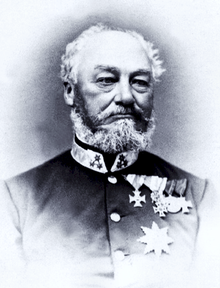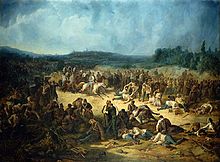Ernst von Hartung
Ernst Ritter von Hartung (born August 23, 1808 in Schwechat ; † October 1, 1879 in Vienna ) was a kk Feldzeugmeister and military theorist, owner of infantry regiment No. 47 and Theresa Knight as well as a real secret council and member of the manor of the Austrian Imperial Council for life.
biography
Years of development
Hartung came from an old knightly family who originally lived in Hanover. His father was a kk captain, later a road construction inspector.
He joined after graduating the Imperial Engineering Academy in 1827 as an ensign in the Infantry Regiment. 1 a, in which he on 15 March 1831. Lieutenant , on August 16, 1834 to lieutenant , and on March 1, 1844 to captain was promoted. In this batch he participated in the battles of 1848 and 1849 in Italy , such as the street fights in Milan from March 15 to 22, the battle near Valeggio on April 9, the battle of Santa Lucia on May 6, the attack the fortified lines of Curtatone and Montanara on May 29th, the reconnaissance of Cerlongo on the 3rd and in the second Corps d'Aspre the capture of Vicenza , especially the latter, with such high distinction in the first corps of Brigadier General Ludwig von Wohlgemuth that he was promoted to Major in Regiment No. 17 by order of Field Marshal Graf Radetzky on June 17, 1848, in addition to the rank tour , and was decorated with the Military Merit Cross with War Decoration (KD.). Hartung then fought in the First Corps in the battle of Custozza on July 25, in the avant-garde battles at Caedo Muri, Basiasco and Turano on July 30 and August 2, in the battle off Milan on August 4, then on August 21. March 1849 during the storming of Borgo San Siro and in the battle at Gambolò , furthermore during the attack and subjugation of Bologna from May 8th to 15th and finally with the encirclement of Ancona from June 5th to 18th. In all of these events he stood out so particularly that he was awarded the Order of the Iron Crown, Third Class, and was promoted to lieutenant colonel. In 1850 he served as Adlatus of Adjutant General Radetzky, whereupon after three months he was appointed Colonel and Commander of Infantry Regiment No. 23.
As a general

On September 25, 1854, he was appointed major general and was a brigadier in the 2nd Army Corps, then in the Serbian-Banat Army Corps. In 1859 he took part with his brigade in the war against France and Piedmont in the 3rd Army Corps, first in the cannonade near Valenza , then he asserted himself in the Battle of Magenta , despite the enemy superiority all night from June 4th to 5th of the year on the battlefield and fought in the Battle of Solferino before Giudizzolo against the strong enemy infantry units advancing from Medole via Casanuova, despite heavy artillery fire and a huge cavalry attack by the enemy, steadfastly until general retreat. For his achievements in the two battles, Hartung was awarded the Order of the Iron Crown 2nd Class and the Knight's Cross of the Leopold Order, both with the War Decoration (KD.).
On August 15, 1862 he was appointed troop commander in the coastal region and in Istria and the officers of the 14th Infantry Regiment dedicated a saber to him before he was promoted to field marshal lieutenant on August 13, 1863. and on May 12, 1864 holder of Infantry Regiment No. 47. As such, Hartung commanded the 9th Army Corps in Archduke Albrecht's southern army during the Italian campaign in 1866 and, through his leadership, contributed significantly to the fact that the Battle of Custozza on 24 June turned into one of the most brilliant victories of the imperial army. In proper appreciation of the combat and terrain conditions and contrary to the dispositions of the General Command, which had ordered the expansion of his corps to the Stafallo valley, Hartung let the right wing of his corps take action against the enemy immediately after the occupation of Sommacampagna and Berettara his repeated attacks against the enemy troops posted on Monte Croce prevented the whole army from being seriously endangered. The enemy failed to advance against the heights of Casa del Sole. After the bloody attacks by his brigades Weckbecker and Böck and the stubborn resistance on the part of the Thun Regiment on the Belvedere and Monte Arabico, which made the attack of the 7th Army Corps much easier, the general was able to do his task for hours only through courageous perseverance and that excellently directed fire would do justice to its almost isolated artillery, but then at the decisive moment preferred its last reserve and used it so carefully against Monte Croce that the position was taken alongside the enemy artillery.

For his actions in the Battle of Custozza, he received the Knight's Cross of the Maria Theresa Order (166th doctorate on August 29, 1866) by the highest resolution of Emperor Franz Joseph I on August 29, 1866, after he had previously been granted the dignity of a secret Council had been awarded. On October 4 of the same year he was appointed interim commanding general for Upper and Lower Austria, Salzburg, Moravia and Silesia, and on March 20, 1868 as the real commanding general in Vienna. After he had advanced to Feldzeugmeister on April 22, 1868, he was awarded the Order of the Iron Crown 1st Class on February 19, 1869 and retired on March 1, 1869 at his own request.
The general, an excellently educated officer and brilliant stylist, was also an important military theorist. He had led the revision of the service regulations and participated in the revision of the drill regulations that began after the war in 1859. His work in this regard continued in the following decades of reorganization of the imperial and royal army. After his retirement, he was appointed a lifelong member of the manor house, regularly took part in all meetings, was repeatedly sent to the delegations of the Austrian Imperial Council and also devoted the greatest attention to all army matters. Any of his high orders would have justified elevation to the baron class, but the general never made a motion in this regard.
At his solemn funeral on October 4, 1879, numerous high-ranking dignitaries met in the court church of St. Augustin, including the Archdukes Albrecht (see above), Archduke Wilhelm and Archduke Rainer and Prime Minister Eduard Graf Taaffe . Feldzeugmeister Joseph Freiherr von Maroicic led the conduct to the Vienna Central Cemetery .
Awards (selection)
The general has received numerous awards, including:
- Order of the Iron Crown 3rd Class , 1849
- K. k. Military Merit Cross with War Decoration (KD.) , 1849
- Order of the Iron Crown 2nd class with the war decoration (KD.) 1859
- Knight of the Austro-Imperial Leopold Order with the war decoration (KD.) , 1859
- Knight's Cross of the Military Maria Theresa Order , 1866
- Order of the Iron Crown 1st Class , 1869
- Royal Order of the Two Sicilies
literature
- Jan Lukeš: “Military Maria Theresa Order - About Authorization of the Order according to authentic sources”, KK Hof- und Staatsdruckerei, Vienna 1890
- Oscar Criste: Hartung, Ernst Ritter von . In: Allgemeine Deutsche Biographie (ADB). Volume 50, Duncker & Humblot, Leipzig 1905, p. 34 f.
- Nikolaus von Preradovich : Hartung, Ernst Ritter von. In: New German Biography (NDB). Volume 8, Duncker & Humblot, Berlin 1969, ISBN 3-428-00189-3 , p. 8 ( digitized version ).
Individual evidence
- ↑ a b NDB, German biography
- ↑ a b ADB, German biography
- ↑ a b c Gustav Amon von Treuenfest: "History of the Imperial and Royal Infantry Regiment No. 47", p. 766 ff.
- ^ A b c Antonio Schmidt-Brentano: The kk or kuk Generalität 1816–1918, Austrian State Archives, Vienna 2007, p. 65
- ^ Theodor Ritter von Zeynek, An officer in the general staff remembers, Böhlau Verlag GmbH, Vienna - Cologne - Weimar 2009, p. 123
- ^ Wilhelm Erben: "Catalog of the K. and K. Heeresmuseums", Vienna 1899, p. 295, no. 346
- ↑ MTO
- ↑ Wiener Zeitung No. 232, from Sunday, October 5, 1879, p. 2
- ↑ Wiener Abendpost No. 227, from Thursday, October 2, 1879, p. 2
| personal data | |
|---|---|
| SURNAME | Hartung, Ernst von |
| ALTERNATIVE NAMES | Hartung, Ernst Ritter von (full name) |
| BRIEF DESCRIPTION | Austrian Feldzeugmeister and military theorist |
| DATE OF BIRTH | August 23, 1808 |
| PLACE OF BIRTH | Schwechat |
| DATE OF DEATH | October 1, 1879 |
| Place of death | Vienna |



